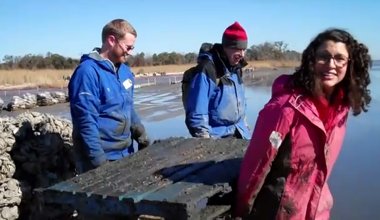 Volunteers from across the country are rebuilding oyster reefs along the Gulf of Mexico shoreline, hoping to revive oyster beds weakened by the BP oil spill and decades of overharvesting and human encroachment.
Volunteers from across the country are rebuilding oyster reefs along the Gulf of Mexico shoreline, hoping to revive oyster beds weakened by the BP oil spill and decades of overharvesting and human encroachment.
Donning boots and gloves, 550 volunteers descended on Mobile Bay over the weekend with 16,000 bags of oyster shells, reef building material to complete the first in a series of shoreline habitat projects aimed at restoring Alabama’s Gulf coast.
Over the past few decades, coastal Alabama has lost its marshes, sea grass beds and oyster reef habitats through incompatible development practices, erosion, storm events, and most recently, the impacts of the Gulf oil disaster.
“When I was young, we waded through these waters looking for flounder in thick beds of seagrass. When the oyster reefs were destroyed, the seagrass and flounder all disappeared. But what fun it was to get my feet wet again, rebuilding the oyster reefs that will welcome the grasses, flounder and shrimp back home,” said Bill Finch, senior fellow with The Ocean Foundation.
Formed after the Gulf oil spill last year, the 100-1000: Restore Coastal Alabama Partnership — led by the Nature Conservancy and 20 other groups — aims to build 100 miles of oyster reefs and grow 1,000 acres of marsh and sea grass to make coastal areas more resilient to hurricanes, oil spills and climate change.
Volunteers from California, Colorado, Massachusetts, Texas, Florida and points in between participated in the inaugural event. For many, it was one of their first opportunities to actively engage in Gulf Coast restoration efforts in the wake of the Deepwater Horizon oil disaster.
The project provides people with the opportunity to have a significant impact on the future of the Gulf. Funding is ongoing for the 100-1000 project, thanks in part to the U.S. Fish and Wildlife Service, Alabama Wildlife Federation, National Wildlife Federation, and NOAA, National Oceanic and Atmospheric Administration.
WATCH the video from the event below…



















